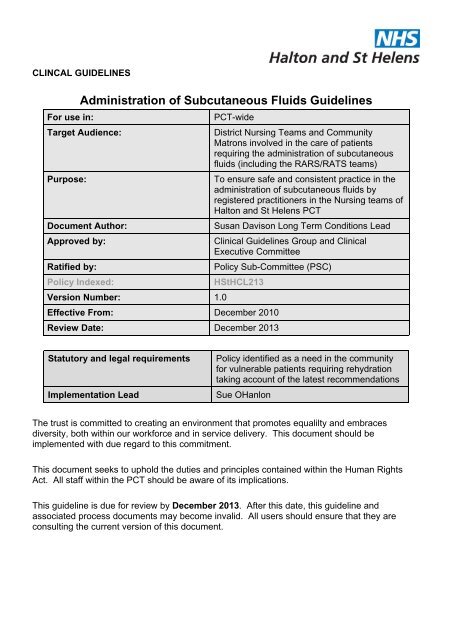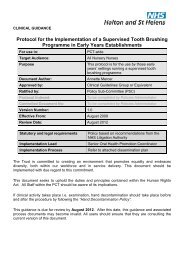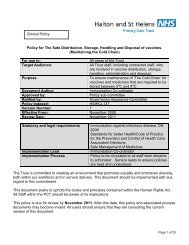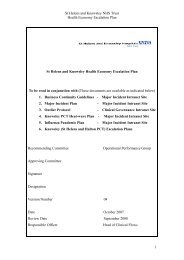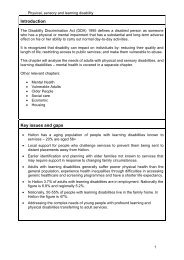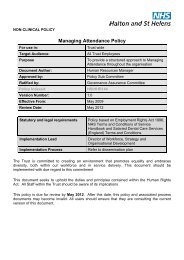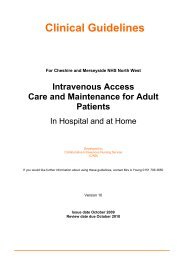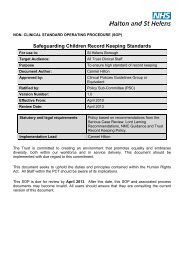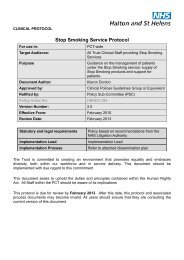Administration of Subcutaneous Fluids Guidelines - Halton and St ...
Administration of Subcutaneous Fluids Guidelines - Halton and St ...
Administration of Subcutaneous Fluids Guidelines - Halton and St ...
You also want an ePaper? Increase the reach of your titles
YUMPU automatically turns print PDFs into web optimized ePapers that Google loves.
CLINCAL GUIDELINES<br />
<strong>Administration</strong> <strong>of</strong> <strong>Subcutaneous</strong> <strong>Fluids</strong> <strong>Guidelines</strong><br />
For use in:<br />
PCT-wide<br />
Target Audience:<br />
District Nursing Teams <strong>and</strong> Community<br />
Matrons involved in the care <strong>of</strong> patients<br />
requiring the administration <strong>of</strong> subcutaneous<br />
fluids (including the RARS/RATS teams)<br />
Purpose:<br />
To ensure safe <strong>and</strong> consistent practice in the<br />
administration <strong>of</strong> subcutaneous fluids by<br />
registered practitioners in the Nursing teams <strong>of</strong><br />
<strong>Halton</strong> <strong>and</strong> <strong>St</strong> Helens PCT<br />
Document Author:<br />
Susan Davison Long Term Conditions Lead<br />
Approved by:<br />
Clinical <strong>Guidelines</strong> Group <strong>and</strong> Clinical<br />
Executive Committee<br />
Ratified by:<br />
Policy Sub-Committee (PSC)<br />
Policy Indexed:<br />
H<strong>St</strong>HCL213<br />
Version Number: 1.0<br />
Effective From: December 2010<br />
Review Date: December 2013<br />
<strong>St</strong>atutory <strong>and</strong> legal requirements<br />
Implementation Lead<br />
Policy identified as a need in the community<br />
for vulnerable patients requiring rehydration<br />
taking account <strong>of</strong> the latest recommendations<br />
Sue OHanlon<br />
The trust is committed to creating an environment that promotes equalilty <strong>and</strong> embraces<br />
diversity, both within our workforce <strong>and</strong> in service delivery. This document should be<br />
implemented with due regard to this commitment.<br />
This document seeks to uphold the duties <strong>and</strong> principles contained within the Human Rights<br />
Act. All staff within the PCT should be aware <strong>of</strong> its implications.<br />
This guideline is due for review by December 2013. After this date, this guideline <strong>and</strong><br />
associated process documents may become invalid. All users should ensure that they are<br />
consulting the current version <strong>of</strong> this document.
Key individuals involved in developing the document<br />
Name<br />
Designation<br />
Sue Davison<br />
Long Term Conditions Lead<br />
Linda Spooner<br />
Pr<strong>of</strong>essional Development Manager<br />
Gill Clare<br />
Medicines Management<br />
Tracey Maskell<br />
District Nurse Team Leader<br />
Circulated to the following for comments<br />
Committee<br />
Committee<br />
Members <strong>of</strong> the Policy Sub Committee<br />
Members <strong>of</strong> the Clinical <strong>Guidelines</strong> Group<br />
Members <strong>of</strong> the Clinical Executive Committee<br />
Individual<br />
Name<br />
Sue O’Hanlon<br />
Sharon Woods<br />
Victoria Heilbron<br />
Lorraine Hodson<br />
Designation<br />
IV lead nurse<br />
Palliative lead<br />
Divisional manager<br />
Clinical Service Manager District Nursing
Table <strong>of</strong> Contents<br />
Rationale................................................................................................................................. - 5 -<br />
Objectives ............................................................................................................................... - 5 -<br />
Target Group........................................................................................................................ - 6 -<br />
Related Policies.................................................................................................................... - 6 -<br />
Indications for <strong>Administration</strong> <strong>of</strong> <strong>Subcutaneous</strong> <strong>Fluids</strong> ......................................................... - 6 -<br />
Indications for the <strong>Administration</strong> <strong>of</strong> <strong>Subcutaneous</strong> <strong>Fluids</strong> in Palliative Care ....................... - 7 -<br />
Contraindications.................................................................................................................. - 8 -<br />
Education <strong>and</strong> Training ........................................................................................................... - 8 -<br />
Equipment Required............................................................................................................. - 8 -<br />
Suitable sites for infusion ..................................................................................................... - 8 -<br />
Suitable <strong>Fluids</strong>...................................................................................................................... - 9 -<br />
Patient Monitoring ...............................................................................................................- 10 -<br />
Complications/side effects...................................................................................................- 11 -<br />
Calculation/rate <strong>of</strong> subcutaneous infusion...........................................................................- 11 -<br />
<strong>Guidelines</strong> ..............................................................................................................................- 12 -<br />
References.............................................................................................................................- 15 -<br />
Appendix 1 .............................................................................................................................- 17 -<br />
Symptoms <strong>of</strong> Dehydration ...................................................................................................- 17 -<br />
Appendix 3 .............................................................................................................................- 18 -<br />
Diagrams.............................................................................................................................- 18 -<br />
Appendix 4 .............................................................................................................................- 19 -<br />
<strong>Subcutaneous</strong> Insertion Sites Diagram ...............................................................................- 19 -<br />
Appendix 5 .............................................................................................................................- 20 -<br />
<strong>Subcutaneous</strong> <strong>Fluids</strong> Monitoring Chart ...............................................................................- 20 -<br />
Appendix 6 .............................................................................................................................- 21 -<br />
Equality Impact Assessment Tool .......................................................................................- 21 -
Appendix 7 .............................................................................................................................- 22 -<br />
Dissemination <strong>and</strong> Training Plan.........................................................................................- 22 -
RATIONALE<br />
This guidance has been developed to highlight the need for a collaborative approach for district<br />
nurses <strong>and</strong> community matrons considering the administration <strong>of</strong> subcutaneous fluids. Also to<br />
explore the complexity for the medical <strong>and</strong> ethical issues in the decision making process with<br />
the aim <strong>of</strong> improving nursing practice <strong>and</strong> patient outcomes. Due to the relative ease <strong>of</strong> setting<br />
up <strong>and</strong> administering subcutaneous fluids, the procedure can be carried out in the home by<br />
district nurses <strong>and</strong> community matrons (Marsden 2004) or anyone who possesses the<br />
necessary knowledge <strong>and</strong> skills for safe practice. However it should be noted that good<br />
practice suggests that decisions regarding artificial hydration should involve a multipr<strong>of</strong>essional<br />
team, the patient, relatives <strong>and</strong> carers, but the senior doctor responsible for the care has<br />
ultimate responsibility for the decision.<br />
Hypodermoclysis (subcutaneous infusion) is a relatively safe, simple <strong>and</strong> cost effective<br />
technique for use in the community with a range <strong>of</strong> client groups, for example older people.<br />
However its use in palliative care raises problems in terms <strong>of</strong> clinical evidence <strong>and</strong> ethical<br />
issues which need to be addressed i.e. products not being licensed for this specific use, staff<br />
requests for clinical guidance <strong>and</strong> the anticipated increasing use <strong>of</strong> hypodermoclysis for<br />
rehydration (Moriarty 2001).<br />
Hypodermoclysis is a way <strong>of</strong> maintaining hydration. Over the past years, this method has been<br />
used increasingly for rehydration in care <strong>of</strong> the elderly settings where dehydration can be a<br />
common problem. The low technological nature <strong>of</strong> this method means that it is well suited to<br />
less acute care settings. This method also has great potential for use in people who have<br />
problems swallowing or other problems which make them prone to dehydration but do not<br />
necessarily mean that they need to be care for in the hospital setting. Patients recovering from<br />
a recent cerebra-vascular accident or those experiencing milder nausea <strong>and</strong> vomiting following<br />
chemotherapy <strong>and</strong> palliative care intervention(s). <strong>Subcutaneous</strong> hydration is not adequate or<br />
appropriate to correct severe dehydration or electrolyte imbalance <strong>and</strong> as such, these patients<br />
will continue to need inpatient services for thorough assessment <strong>and</strong> treatment.<br />
These guidelines have been written to act as a guide in the decision making process. They are<br />
intended to support the nurses undertaking the procedure <strong>of</strong> commencing <strong>and</strong> maintaining<br />
subcutaneous infusions once the decision has been made to commence treatment.<br />
OBJECTIVES<br />
These guidelines aim to make nurses aware <strong>of</strong> the following:<br />
<br />
<br />
<br />
The evidence base for practice, life long learning <strong>and</strong> pr<strong>of</strong>essional self-regulation (Zeh<br />
2002)<br />
Indication for the administration <strong>of</strong> subcutaneous fluids for patients<br />
Ethical <strong>and</strong> medical considerations in the assessment <strong>of</strong> patients in which subcutaneous<br />
fluids may be considered an appropriate treatment.<br />
<br />
The method <strong>of</strong> administration <strong>of</strong> subcutaneous fluids. Ensure they are administered in a<br />
safe manner by appropriately, qualified competent staff.
Practitioners must always adhere to the NMC Code <strong>of</strong> Pr<strong>of</strong>essional Conduct (NMC 2008)<br />
when considering matters <strong>of</strong> clinical judgement <strong>and</strong> pr<strong>of</strong>essional accountability.<br />
Target Group<br />
District Nurses <strong>and</strong> Community Matrons (including the RARS/RATS teams) involved in the care<br />
<strong>of</strong> patients requiring the administration <strong>of</strong> subcutaneous fluids.<br />
Related Policies<br />
PCT Record Keeping Policy<br />
PCT Infection Control Policy<br />
SOP for the Disposal <strong>of</strong> Sharps<br />
PCT Consent Policy<br />
PCT Medicines Management Policy<br />
PCT Health <strong>and</strong> Safety Policies<br />
PCT Procedure for the Treatment <strong>of</strong> Anaphylaxis<br />
Indications for <strong>Administration</strong> <strong>of</strong> <strong>Subcutaneous</strong> <strong>Fluids</strong><br />
Evidence to support the procedure in older people is not extensive although there are great<br />
numbers <strong>of</strong> cases describing its successful application in the community setting. In the single<br />
systematic review <strong>of</strong> this intervention (17 studies) it was concluded that hypodermoclysis could<br />
be safely used with an elderly client group to provide electrolyte-containing fluid, however the<br />
scope <strong>of</strong> the review was limited <strong>and</strong> the authors further pointed out that the majority <strong>of</strong> available<br />
studies were <strong>of</strong> poor quality <strong>and</strong> went on to comment that <strong>of</strong> these studies only two were<br />
r<strong>and</strong>omised control trials (Rochon, Sudeep et al 1997).<br />
The review itself has also been criticised by reviewers from the NHS Centre <strong>of</strong> Reviews <strong>and</strong><br />
Dissemination for failing to include some key features <strong>of</strong> the systematic review process which<br />
includes an observation on the lack <strong>of</strong> information relating to the criteria used to assess the<br />
validity <strong>of</strong> the primary studies <strong>and</strong> the method <strong>of</strong> data extraction. There is a need for further<br />
research in this area <strong>of</strong> practice.<br />
Dehydration can be a common problem in older people, both at home <strong>and</strong> long term care<br />
settings. Acute problems <strong>and</strong> conditions such as mild infections, vomiting <strong>and</strong> diarrhoea <strong>and</strong><br />
temporary confusion could all precipitate dehydration because an adequate fluid intake cannot<br />
be maintained. <strong>Subcutaneous</strong> hydration is not adequate to correct severe dehydration or<br />
electrolyte imbalance. If rehydration is considered essential, alternative methods should be<br />
considered.<br />
Relatively small amounts <strong>of</strong> fluid are administered using this method e.g. one or two litres <strong>of</strong><br />
fluid in a 24 hour period <strong>and</strong> these can be infused continuously either overnight or by short one<br />
or two hour infusions for more mobile patients. Up to three litres can be administered via this<br />
route, but not glucose.
<strong>Subcutaneous</strong> infusions should be used with extreme caution where there is history <strong>of</strong><br />
cardiac/renal failure or in bleeding disorders in patients who have existing fluid overload <strong>and</strong><br />
must be subjected to increase diagnostic monitoring.<br />
Generally the following criteria should be met:<br />
The patient is experiencing symptoms, e.g. thirst, malaise, delirium, confusion for which<br />
dehydration seems the likely cause<br />
Increased oral intake is not feasible or manageable<br />
Anticipation that parental hydration will relieve the symptoms e.g. in patients with severe<br />
dysphasia, vomiting <strong>and</strong> diarrhoea.<br />
Laboratory investigation supports the diagnosis<br />
The patient’s underlying physical condition is relatively good<br />
The patient is willing to have parental hydration<br />
The patient <strong>and</strong> relatives underst<strong>and</strong> fully underst<strong>and</strong> that the purpose <strong>of</strong> the procedure<br />
is to relieve symptoms <strong>and</strong> reduce distress but not to cure.<br />
It is advisable initially to set a provisional time limit for parental hydration (Hypodermaclysis)<br />
after which further assessment <strong>and</strong> discussion should be made by the multipr<strong>of</strong>essional team.<br />
Indications for the <strong>Administration</strong> <strong>of</strong> <strong>Subcutaneous</strong> <strong>Fluids</strong> in Palliative Care<br />
There is little evidence that artificial hydration in dying patients influences neither survival nor<br />
symptom control. Dehydration is a common problem with patients in the terminal phase <strong>of</strong> an<br />
illness <strong>and</strong> is associated with many possible causes. One <strong>of</strong> the most difficult <strong>and</strong><br />
uncomfortable symptom is that <strong>of</strong> thirst. Drug therapy <strong>and</strong> medication can also lead to an<br />
altered thirst sensation. Appendix 1 outlines the symptoms associated with dehydration in<br />
palliative care.<br />
In palliative care, indications for the need for parental hydration should be symptom led <strong>and</strong><br />
following discussion with the palliative care team, McMillan’s as well as the senior doctor caring<br />
for the patient. Some cancer patients experience reversible conditions such as hypercalcaemia<br />
which may cause dehydration. Dehydration can increase the risk <strong>of</strong> pressure ulcer formation.<br />
Hypercalceamia can develop in cancer patients, particularly if there is disease in the bone. It is<br />
easily treatable <strong>and</strong> its effects if untreated include renal failure <strong>and</strong> cardiac arrhythmias <strong>and</strong><br />
hypercalceamia is a contraindication for administration <strong>of</strong> subcutaneous fluids. To confirm the<br />
presence <strong>of</strong> hypercalceamia a simple blood test is all that is needed along side visible common<br />
symptoms which include, nausea, vomiting, increased thirst, increased pain (especially in the<br />
bone), urinary frequency, tiredness, confusion, poor appetite, constipation, personality changes,<br />
visual disturbances, twitching, co ordination problems <strong>and</strong> anxiety. This should be ruled out in<br />
appropriate patients, prior to using subcutantious fluids. Many authors urge caution in terminally<br />
ill patients. They suggest should only be used if the patient is in someway distressed <strong>and</strong> lack <strong>of</strong><br />
fluid <strong>and</strong> other measures cannot correct symptoms, for example, drug alteration,<br />
hypercalceamia correction <strong>and</strong> effective oral hygiene. The primary goal <strong>of</strong> any treatment in<br />
terminal care should be the comfort <strong>of</strong> the patient <strong>and</strong> the ethical basis <strong>of</strong> most clinical decision<br />
making is the assessment <strong>of</strong> the benefit.
Contraindications<br />
Clotting disorders<br />
Shock<br />
Severe dehydration<br />
Cardiac failure<br />
Pre-renal or renal failure<br />
Low platelet or coagulation disorders<br />
Existing fluid overload<br />
Marked/pitting oedema<br />
The patient requests not to have an invasive procedure<br />
The sum <strong>of</strong> the burden <strong>of</strong> parental hydration outweighs the likely benefits<br />
The patient is moribund for reasons other than dehydration.<br />
If it is not in the patient’s best interest, subcutaneous hydration should not be introduced simply<br />
to satisfy relatives/carers who insist that something must be done. (Twycross 1997).<br />
EDUCATION AND TRAINING<br />
The PCT will provide training to all district nurses <strong>and</strong> community matrons (including RARS <strong>and</strong><br />
RATS) who will be involved in the administration <strong>of</strong> subcutaneous fluids using a competency<br />
framework. It is the individual nurse’s responsibility to constantly review competence <strong>and</strong> keep<br />
their knowledge <strong>and</strong> skills updated.<br />
Equipment Required<br />
<strong>St</strong>erile dressing pack with gloves<br />
Apron<br />
Prescribed fluid <strong>and</strong> signed prescription sheet<br />
<strong>St</strong><strong>and</strong>ard intravenous giving set<br />
21-25g butterfly needle infusion set or s<strong>of</strong> – set infusion set, (see appendix 3)<br />
Infusion line<br />
Semi-permeable film dressing<br />
Sharps bin<br />
Portable drip st<strong>and</strong><br />
Fluid Balance chart<br />
Cloraprep<br />
Suitable sites for infusion<br />
Abdomen
Chest (avoiding sort breast tissue)<br />
Lateral aspect <strong>of</strong> upper arm or thigh<br />
Back, usually below shoulder blades. (May be useful in confused patients) (see appendix<br />
4)<br />
Do not use on:<br />
Lymphoedematous tissue<br />
Skin which has been irradiated<br />
Where there is evidence <strong>of</strong> existing rash<br />
Peripheral limbs e.g. below knee or elbow<br />
Bony prominences<br />
Lack <strong>of</strong> sub cut tissue<br />
Lateral aspect <strong>of</strong> upper arm or thigh<br />
Mastectomy sites<br />
Oedematous tissue<br />
Close to stoma or PEG site<br />
Rotation <strong>of</strong> sites is recommended to minimise tissue damage.<br />
Suitable <strong>Fluids</strong><br />
(Should be isotonic)<br />
Sodium Chloride 0.9% or 4.5%<br />
Sodium Chloride 0.18% & Dextrose 4%<br />
If solutions <strong>of</strong> glucose 5% used, no more than 2 litres in 24 hours (using a single site)<br />
CAUTION the pH <strong>of</strong> glucose 5% (3.5 – 6.5) can cause irritation to the site. The rate<br />
should not exceed 2mls per hour/ a litre in 8 hours. CAUTION rapid infusion <strong>of</strong><br />
electrolyte – free solutions can lead to hypertension <strong>and</strong> shock.<br />
CAUTION Potassium solutions can cause ulceration <strong>and</strong> damage to tissues.<br />
Other fluids may be prescribed however Sodium Chloride would be the fluid <strong>of</strong> choice in the<br />
administration <strong>of</strong> subcutaneous fluids.<br />
NOTE<br />
The manufacturers <strong>of</strong> fluids for infusion are granted product licensing for the purpose <strong>of</strong><br />
intravenous infusion only. Therefore the use <strong>of</strong> these sterile liquids for the purpose <strong>of</strong><br />
subcutaneous infusion must be considered as an unlicensed procedure. This should be<br />
communicated to patients / relatives when gaining consent for the procedure. The medical<br />
prescriber must take full responsibility in relation to any adverse effects resulting from its use.<br />
The prescriber should complete a request for whom they are prescribing the supply <strong>of</strong> the<br />
specific infusion fluid <strong>and</strong> the name <strong>of</strong> the patient for whom they are prescribing the fluid as an<br />
unlicensed procedure. Also the prescriber needs to complete the drug administration sheet,
giving details <strong>of</strong> date the fluid to be administered, the route <strong>and</strong> frequency <strong>and</strong> length <strong>of</strong><br />
treatment.<br />
Patient Monitoring<br />
Patients under the care <strong>of</strong> the district nursing teams <strong>and</strong>/or community matrons will have their<br />
needle site <strong>and</strong> infusion rate checked at each visit (<strong>and</strong> one hour after 1 st visit commencing<br />
treatment). The infusion site should be checked for:<br />
<br />
<br />
<br />
<br />
<br />
<br />
<br />
Pain/tenderness<br />
Redness<br />
Inflammation/oedema<br />
Leakage<br />
Bleeding/bruising<br />
Abscess formation<br />
Fluid overload<br />
Refer to appendix 5 as a prompt <strong>and</strong> record for a subcutaneous monitoring chart,<br />
guidance score <strong>and</strong> advice for subcutaneous site.<br />
Patient’s families/carers will be instructed by the nursing teams on how to monitor the needle<br />
site <strong>and</strong> what to do in the event on the needle becoming displaced.<br />
The butterfly needle <strong>and</strong> site should be changed every 48 hours <strong>and</strong> the change recorded in the<br />
patient notes. The giving set should be changed every day but should be changed each time<br />
the fluids are administered if the infusion is not continuous.<br />
The patient should be checked at each visit for signs <strong>of</strong> pulmonary oedema e.g. dyspnoea <strong>and</strong><br />
peripheral oedema. Signs <strong>of</strong>ten associated with pulmonary oedema could include:<br />
<br />
<br />
<br />
<br />
<br />
<br />
<br />
<br />
<br />
<br />
<br />
<br />
Extreme shortness <strong>of</strong> breath <strong>and</strong> difficulty breathing<br />
A bubbly, wheezing, or gasping sound when trying to breath.<br />
Anxiety, restlessness or a sense <strong>of</strong> apprehension<br />
A cough that produces frothy sputum that may be tinged with blood<br />
Excessive sweating<br />
A blue, grey or pale colouration to skin<br />
A rapid irregular heartbeat or palpitations<br />
Rapid weight gain <strong>and</strong> fluid retention<br />
Loss <strong>of</strong> appetite<br />
Fatigue<br />
Headache<br />
A severe drop in blood pressure
Ankle, leg <strong>and</strong> abdominal swelling<br />
The patient should be monitored within one hour <strong>of</strong> the infusion commencing <strong>and</strong> then six to<br />
eight hourly for the next forty eight hours. Subsequent visits are dependent on the infusion rate<br />
<strong>and</strong> infusion quantity.<br />
Complications/side effects<br />
Complication can occur at any time from hours following commencement to over 3 years,<br />
dependent on the condition <strong>of</strong> the patient <strong>and</strong> the fluids infused. (Twycross et al 1998).<br />
The needle should be removed <strong>and</strong> resisted if any <strong>of</strong> the above conditions occurs.<br />
Possible side effects <strong>of</strong> subcutaneous fluid infusion include generalised oedema, local oedema<br />
or local skin reaction.<br />
Calculation/rate <strong>of</strong> subcutaneous infusion<br />
As the fluid is infused by gravity, an electronic pump to regulate the flow/rate <strong>of</strong> administration is<br />
not required.<br />
To set up a manually controlled drip accurately by eye, the number <strong>of</strong> drops per minute need to<br />
be counted, then applied to the formula below:<br />
RATE = VOLUME (IN DROPS)<br />
TIME (IN MINUTES)<br />
To calculate the volume in drops, it is necessary to know how many drops are contained within<br />
one millilitre (ml). This information should be available on the packaging <strong>of</strong> the administration<br />
set.<br />
The volume in mls is then multiplied by the number <strong>of</strong> drops per ml to give the volume in drops.<br />
Similarly to find the rate in minutes, change the hours into minutes by multiplying by 60 (Hutton<br />
1990)<br />
Two common sizes are 20 drops per ml <strong>and</strong> 15 drops per ml.<br />
Examples <strong>of</strong> calculations:<br />
1000mls (volume <strong>of</strong> infusion) x 20 drops = 20,000 = 27.7 drops<br />
12 (hours) x 60 (minutes) 720<br />
1000mls (volume <strong>of</strong> infusion) x 15 drops = 15,000 = 20.8 drops<br />
12 (hours) x 60 (minutes) 720
These calculations should be rounded up to the whole number <strong>and</strong> recorded in the patient’s<br />
records.<br />
Usual rates <strong>of</strong> infusions can vary from 500mls <strong>of</strong> fluid over 8 hours to a maximum <strong>of</strong> 2 to 3 litres<br />
<strong>of</strong> fluid in 24 hours.<br />
Most low volumes <strong>of</strong> suitable fluids can be administered subcutaneously without any problems.<br />
If however localised oedema becomes a problem with fluid volumes <strong>of</strong> 2 litres over 24 hours or<br />
1 litre over 8 hours. A drug called Hyaluronidase (Hyalase) can be given to try <strong>and</strong> eliminate or<br />
prevent localised oedema at the site.<br />
The usual dose is 1500iu per site per 24 hours. It is dissolved in saline 0.9% (enough to prime<br />
the line, approximately 17.3mls, plus 0.5mls). This is through a Baxters Solution giving set.<br />
It MUST NOT be added to the fluid bag but is injected as a sub-cut bolus injection.<br />
GUIDELINES FOR SETTING UP INFUSION<br />
ACTION<br />
This procedure should only be carried out as<br />
part <strong>of</strong> a planned programme <strong>of</strong> care, following<br />
discussion with the patient’s medical<br />
practitioner, the patient <strong>and</strong> their<br />
families/carers.<br />
All medications <strong>and</strong> fluids required for this<br />
procedure must be prescribed by the medical<br />
practitioner responsible for the patients care.<br />
Prepare the patient <strong>and</strong> explain the procedure,<br />
including the risks <strong>and</strong> benefits. Evidence that<br />
this has been done must be documented in the<br />
patients record. If possible, the patients<br />
should sign the care plan.<br />
Check the fluid to be administered with the<br />
signed prescription sheet. The prescription<br />
sheet must be signed together with the dose,<br />
infusion rate <strong>and</strong> route <strong>of</strong> administration.<br />
NB: If hydrating a dying patient, the<br />
infusion should be limited to 500mls – 1<br />
litre per day.<br />
Ensure all equipment is assembled<br />
Prime the giving set <strong>and</strong> the butterfly needle<br />
with the fluid to be infused.<br />
Assess the patient for a suitable area, either<br />
abdomen, chest or lateral aspects <strong>of</strong> upper<br />
RATIONALE<br />
To ensure that all other options have been<br />
explored <strong>and</strong> the patient is suitable for this<br />
procedure to be carried out in the home.<br />
To conform with NMC st<strong>and</strong>ards for the<br />
administration <strong>of</strong> medicines <strong>and</strong> to fulfil the<br />
legal requirement.<br />
To obtain informed consent <strong>and</strong> co-operation<br />
<strong>of</strong> the patient<br />
To ensure correct type <strong>of</strong> fluid <strong>and</strong> quantity<br />
administered at correct rate.<br />
To reduce undue anxiety to the patient <strong>and</strong> for<br />
ease <strong>of</strong> carrying out the procedure.<br />
To prevent air bubble formation in the cannula<br />
(Nobel-Adams 1995)<br />
To provide a comfortable <strong>and</strong> safe area for<br />
fluid absorption.
arm or thigh. (Noel-Adams 1995, Watt 1991)<br />
Wash <strong>and</strong> dry h<strong>and</strong>s thoroughly or use alcohol<br />
based h<strong>and</strong> wash. This is a clean procedure<br />
Ensure that the site is clean.<br />
Pinch the skin into a fold. Clean site with<br />
Choraprep then air dry<br />
Insert the butterfly needle into the chosen site<br />
at an angle <strong>of</strong> 45 degrees with the bevelled<br />
edge facing uppermost. (Abdulla, Keast 1997,<br />
Nobel-Adams 1995)<br />
NB: If blood appears in the line on insertion<br />
<strong>of</strong> the butterfly needle, withdraw<br />
immediately <strong>and</strong> repeat the process.<br />
(Berger 1984)<br />
Coil the butterfly line <strong>and</strong> place a semipermeable<br />
film dressing over the butterfly site<br />
(Nobel-Adams 1995)<br />
Ensure that the patient is comfortable.<br />
Inform the patient/carer what actions to take<br />
should any problems arise with either the<br />
infusion or the site.<br />
Ensure that the patient/carer has contact<br />
details for day, evening <strong>and</strong> night community<br />
nursing services.<br />
Set the infusion at the prescribed rate using<br />
the infusion table (page 9)<br />
Record the date <strong>and</strong> time commenced in the<br />
patient records together with the batch number<br />
<strong>and</strong> expiry date <strong>of</strong> the fluid(s) used.<br />
Commence a fluid balance chart.<br />
Check the infusion site one hour after<br />
commencing <strong>and</strong> then 6-8 hourly for the next<br />
24 hours.<br />
At each visit, check the site for:<br />
Local irritation<br />
Redness<br />
Tenderness<br />
Swelling<br />
Inflammation<br />
Fluid monitoring chart to be used.<br />
Resite as necessary (following the above<br />
actions)<br />
The site should be changed at least every 48<br />
To comply with universal infection control<br />
precautions;<br />
To reduce the risk <strong>of</strong> site contamination.<br />
To promote patient comfort.<br />
To ensure that a blood vessel has not been<br />
compromised.<br />
To ensure the flow <strong>of</strong> fluids <strong>and</strong> security <strong>of</strong> the<br />
line. Also to protect the site from infection.<br />
To maintain patients dignity <strong>and</strong> safety.<br />
To ensure fluid is administered in accordance<br />
with policy <strong>and</strong> prescription.<br />
To ensure patient safety.<br />
To ensure that any problems are identified<br />
quickly <strong>and</strong> dealt with promptly.<br />
To maintain patient comfort <strong>and</strong> dignity.<br />
Ensure the adequate <strong>and</strong> safe absorption <strong>of</strong><br />
the fluid(s)<br />
To minimise the risk <strong>of</strong> infection <strong>and</strong> to ensure
hours <strong>and</strong>/or when complications occur,<br />
The site change <strong>and</strong> reason for re-siting must<br />
be recorded in the patients record<br />
Giving sets must be changed at least every<br />
(48 hourly) hours <strong>and</strong> the change recorded in<br />
the patients record (Mallett & Bailey 1996)<br />
the safe administration <strong>of</strong> fluid(s)<br />
To minimise the risk <strong>of</strong> infection,<br />
IF HYALURONIDASE IS BEING USED<br />
Draw up prescribed amount <strong>of</strong> hyaluronidase<br />
in subcutaneous syringe in prescribed amount<br />
<strong>of</strong> 0.9% saline<br />
Prime the butterfly needle <strong>and</strong> the giving set<br />
with the prepared syringe <strong>and</strong> leave the<br />
syringe attached to it.<br />
Hyalase Follow steps 1, 2 <strong>and</strong> 3 <strong>of</strong> above<br />
procedure for subcutaneous infusions.<br />
Pinch up a fold <strong>of</strong> skin from the chosen site<br />
introduce the needle at a 45 degree angle.<br />
Flush through the 0.5 hyaluronidase through<br />
the line into the site<br />
Disconnect the syringe <strong>and</strong> attach the<br />
prescribed fluid for administration to the giving<br />
set. <strong>St</strong>art the infusion at the appropriate rate.<br />
Monitor site as per policy<br />
To ensure the correct drug <strong>and</strong> preparation is<br />
ready to be administered<br />
Preparing to administer medication with only<br />
one injection for the patient for both medication<br />
<strong>and</strong> subcutaneous fluid administration<br />
Ensuring site identified for administration is<br />
identified <strong>and</strong> cleansed appropriately prior to<br />
insertion <strong>of</strong> needle.<br />
To ensure prior to sub cutanious fluid<br />
administration the hyaluronidase is<br />
administered to have desired effect.<br />
Ant remaining hyaluronidase will go through<br />
prior to the reaming fluid. This minimises any<br />
discomfort to the patient <strong>and</strong> maximises the<br />
efficiency <strong>of</strong> the drug<br />
To monitor effectiveness <strong>of</strong> the drug. Ensure<br />
patient comfort is provided.
REFERENCES<br />
Reference<br />
Abdulla A., Keast J., (1997) “Hypodermaclysis as a<br />
means <strong>of</strong> rehydration”., Nursing Times July<br />
16/Vol3/No29<br />
ATM Applied Medical Technology, Disposable<br />
Infusion Sets<br />
Birmingham East <strong>and</strong> North NHS Primary Care<br />
Trust, ( 2006), Policy for the administration <strong>of</strong><br />
subcutaneous fluids.<br />
eMC, The electric Medicines Compendium,<br />
(2008)Hyalase 1500I>U> Powder for Solution for<br />
Injection/Infusion.<br />
http://www.baxterhealthcare.co.uk/products/iv_syst<br />
ems/sets/sub/basic_sets.html. Iv administration<br />
sets.<br />
http:/www.chloraprep.co.uk/chloraPrepproductLine.html<br />
http:/www.chemocare.com., (2009), Side effects –<br />
symptoms <strong>and</strong> solutions, Hypocalcaemia (high<br />
calcium)<br />
htt://www.healthcarea2z.org/ditem.aspx/284/Hypod<br />
ermoclysis. , (2009), subcutaneous fluid<br />
administration (hypodermoclysis)<br />
http://palliative.info. Procedure for subcutaneous<br />
Over-the-needle Cannula Insertion, Removal,<br />
Medication <strong>Administration</strong>, <strong>and</strong> Fluid <strong>Administration</strong><br />
for the Individual in the Home.<br />
Hutton M., (1998) “Numeracy Skills for Intravenous<br />
calculations”, Nursing <strong>St</strong><strong>and</strong>ard July 15/Vol 12/ No<br />
43.<br />
Mallet J., Bailey C., (1996) The Royal Marsden<br />
NHS Trust Manual <strong>of</strong> Clinical Nursing Procedures<br />
4 th Edition, Oxford Blackwell Science, London.<br />
Relevance<br />
(whole<br />
document<br />
or section,<br />
please<br />
state)<br />
2<br />
Whole 2<br />
whole<br />
Whole<br />
Whole<br />
Whole<br />
Whole<br />
E<br />
E<br />
E<br />
E<br />
E<br />
Whole 2<br />
Whole<br />
MayoClinic.com. Pulmonary edema. Pages 1 to 5 E<br />
Moriarty D <strong>and</strong> Hudson (2001), “Hyperdermoclysis<br />
for rehydration in the community”, Journal <strong>of</strong><br />
E<br />
2<br />
E<br />
1<br />
Evidence Grade
Community Nursing Vol 6 No 9.<br />
Nobel-Adam R (1995) “Dehydration.<br />
<strong>Subcutaneous</strong> Fluid <strong>Administration</strong>, British Journal<br />
<strong>of</strong> Nursing 4 pp488-494<br />
Nursing <strong>and</strong> Midwifery Council (2008), <strong>St</strong><strong>and</strong>ards<br />
<strong>of</strong> Conduct, Performance <strong>and</strong> Ethics<br />
Patchett M., (1998) “Providing hydration for the<br />
terminally ill patient” International Journal <strong>of</strong><br />
Palliative Nursing Vol 4 No 3<br />
Pranoy Barua, Bimal K, Bhowmick, (2005),<br />
Hypodermoclysis – a victim <strong>of</strong> historical prejudice.<br />
Robin Fainsinger, MD, (2006), Nonoral hydration in<br />
palliative care#133, Journal <strong>of</strong> Palliative Medicine-9<br />
(1):206<br />
Rochon P., Sudeep et al,: A systematic review <strong>of</strong><br />
the evidence for hypodermoclysis to treat<br />
dehydration in older people. Journal <strong>of</strong><br />
Gerontology, Medical Sciences 1997, Vol 52a No<br />
3, pp 169-176<br />
RCN, <strong>St</strong><strong>and</strong>ards for infusion therapy<br />
<strong>St</strong>einer N (1998) “Methods <strong>of</strong> Hydration in Palliative<br />
Care patients” Journal <strong>of</strong> Palliative Care 14:2 6-13<br />
Tee’s Esk <strong>and</strong> Wear Valleys NHS Foundation<br />
Trust, (2009), Procedure for the administration <strong>of</strong><br />
subcutaneous fluids (hypodermoclysis)<br />
The Royal Marsden NHS Foundation Trust (2006),<br />
The Royal Marsden Hospital Manual <strong>of</strong> Clinical<br />
Procedures. 6 th Edition. Blackwell Publishing,<br />
Oxon pp 194-195<br />
Twycross R., Wilcock A, Thorp S (1998) “Syringe<br />
Drivers” in Palliative Care Formulary, Radcliffe<br />
Medical Press, Oxford pp 182-202.<br />
University hospitals <strong>of</strong> Leicester NHS Trust, (2003)<br />
Policy for the administration <strong>of</strong> subcutaneous fluids<br />
for the hydration <strong>of</strong> adult patients.<br />
Zeh, P., (2002) Clinical Governance <strong>and</strong> the<br />
District Nurse, Journal <strong>of</strong> Community Nursing April<br />
Volume 16<br />
NMC <strong>Guidelines</strong> Record Keeping Policy 2009.<br />
Page 215 to<br />
217<br />
1<br />
E<br />
1<br />
2<br />
Page 206 2<br />
Pages 22 to<br />
44<br />
Whole<br />
Whole<br />
1<br />
E<br />
2<br />
E<br />
E<br />
E<br />
E<br />
2<br />
E
APPENDIX 1<br />
Symptoms <strong>of</strong> Dehydration<br />
Symptoms which may be associated with<br />
dehydration (Patchett 1998)<br />
Thirst<br />
Dry mouth<br />
Dysphasia<br />
Nausea <strong>and</strong> Vomiting<br />
Muscle Cramps<br />
Headache<br />
Apathy<br />
Depression<br />
Vivid nightmares<br />
Disorientation – (delirium, confusion <strong>and</strong><br />
unexpected coma state)<br />
Physical Signs (<strong>St</strong>einer & Breura 1998)<br />
Thirst<br />
Reduced skin turgor<br />
Reduced sweating<br />
Postural hypotension<br />
Tachycardia<br />
Oliguria<br />
However some <strong>of</strong> these signs are less reliable<br />
in advanced cancer patients <strong>and</strong> can be found<br />
without volume depletion.<br />
NB: There should be a review <strong>of</strong> patient’s<br />
medication to determine if they are causing<br />
any <strong>of</strong> the above symptoms.<br />
NB: There should be a review <strong>of</strong> patient’s<br />
medication to determine f they are causing<br />
any <strong>of</strong> the above symptoms.
APPENDIX 3<br />
Diagrams<br />
Needled infusion set<br />
S<strong>of</strong>- set infusion set
APPENDIX 4<br />
<strong>Subcutaneous</strong> Insertion Sites Diagram
APPENDIX 5<br />
<strong>Subcutaneous</strong> <strong>Fluids</strong> Monitoring Chart<br />
<strong>Subcutaneous</strong> <strong>Fluids</strong> Monitoring Chart<br />
Name: ………………………….... DOB: ….……..….. NHS No: ………………………<br />
Date:<br />
Time:<br />
Infusate:<br />
Site / Position:<br />
Appearance:<br />
Signature:<br />
When Considering appearance please use the following guidelines:<br />
A<br />
Site appears intact with no pain on palpation, redness,<br />
swelling or oozing.<br />
Continue infusion.<br />
B<br />
Slight pain on palpation <strong>and</strong>/or redness, swelling or<br />
oozing to a diameter <strong>of</strong> less than o.5cm.<br />
Continue infusion. Check site more frequently.<br />
C<br />
Pain on palpation <strong>and</strong>/or redness, swelling or oozing to a<br />
diameter <strong>of</strong> between o.5cm <strong>and</strong> 2cm.<br />
Discontinue infusion. Resite if appropriate or<br />
consider IV hydration. Complete incident form <strong>and</strong><br />
monitor frequently until symptoms diminish.<br />
D<br />
Pain on palpation <strong>and</strong>/or redness, swelling or oozing to a<br />
diameter <strong>of</strong> greater than 2cm.<br />
Discontinue infusion. Resite if appropriate or<br />
consider IV hydration. Complete incident form <strong>and</strong><br />
monitor frequently until symptoms diminish <strong>and</strong><br />
apply (appropriate dressing)<br />
In acknowledgement <strong>of</strong> University Hospitals <strong>of</strong> Leicester
APPENDIX 6<br />
Equality Impact Assessment Tool<br />
To be completed with the policy document when submitted to the appropriate committee for<br />
consideration, approval <strong>and</strong> ratification.<br />
1. Does the policy/guidance affect one group less or<br />
more favourably than another on the basis <strong>of</strong>:<br />
Yes/No<br />
Race No<br />
Ethnic origins (including gypsies <strong>and</strong> travellers) No<br />
Nationality No<br />
Gender No<br />
Culture No<br />
Religion or belief No<br />
<br />
Sexual orientation including lesbian, gay <strong>and</strong><br />
bisexual people<br />
Age Yes –<br />
Adults<br />
Only<br />
<br />
Disability - learning disabilities, physical disability,<br />
sensory impairment <strong>and</strong> mental health problems<br />
2. Is there any evidence that some groups are<br />
affected differently<br />
3. If you have identified potential discrimination, are<br />
there any exceptions valid, legal <strong>and</strong>/or<br />
justifiable<br />
4. Is the impact <strong>of</strong> the policy/guidance likely to be<br />
negative<br />
5. If so can the impact be avoided No<br />
6. What alternative are there to achieving the<br />
policy/guidance without the impact<br />
7. Can we reduce the impact by taking different<br />
action<br />
No<br />
No<br />
No<br />
No<br />
No<br />
No<br />
No<br />
Comments<br />
If you have identified a potential discriminatory impact <strong>of</strong> this policy document, please refer it to<br />
[insert name <strong>of</strong> appropriate person], together with any suggestions as to the action required to<br />
avoid/reduce this impact. For advice in respect <strong>of</strong> answering the above questions, please<br />
contact [insert name <strong>of</strong> appropriate person <strong>and</strong> contact details].
APPENDIX 7<br />
Dissemination <strong>and</strong> Training Plan<br />
To be completed with the policy document when submitted to the appropriate committee for<br />
consideration, approval <strong>and</strong> ratification.<br />
The status column must be given a Red, Amber or Green rating with evidence to demonstrate<br />
an action has been completed.<br />
DISSEMINATION PLAN<br />
Title <strong>of</strong> document: <strong>Administration</strong> <strong>of</strong> Sub<br />
Cut <strong>Fluids</strong><br />
Dissemination Lead: (Print name <strong>and</strong><br />
contact details) Sue OHanlon<br />
Irwin Road Clinic<br />
Date finalised: December 2010<br />
Previous document already being used<br />
appropriate)<br />
If yes, in what format <strong>and</strong> where<br />
No (Please delete as<br />
Proposed action to retrieve out-<strong>of</strong>-date<br />
copies <strong>of</strong> the document:<br />
To be disseminated to:<br />
District Nurses/Community Matrons/<br />
RARs/RATs<br />
TRAINING PLAN<br />
Withdraw from the internet/intranet/portal<br />
Disseminated<br />
by whom<br />
Community<br />
Service<br />
Managers<br />
Event (Please provide details <strong>of</strong> available training venues/dates to<br />
educate staff about this policy document)<br />
Timescale<br />
(Date)<br />
December<br />
2010<br />
<strong>St</strong>atus<br />
R A G<br />
Paper<br />
or<br />
Electronic<br />
Electronic<br />
Comments<br />
Timescale Owner <strong>St</strong>atus<br />
R A G<br />
To be incorporated into the ongoing IV training programme January 2011 Sue<br />
OHanlon<br />
Training Plan Lead (Please provide details <strong>of</strong> staff who will be<br />
responsible for overseeing this training)<br />
Sue OHanlon<br />
Additional information (Please provide details <strong>of</strong> any processes in place<br />
to support implementation)<br />
To be<br />
incorporated<br />
into IV<br />
Introduction<br />
study days<br />
throughout<br />
the coming<br />
year<br />
Denotes: Action not yet taken or deadline for action not met. Action plan to address this must be provided.<br />
Denotes: Action partially implemented.<br />
Denotes: Action complete.


